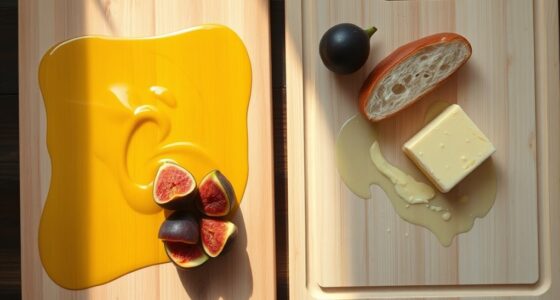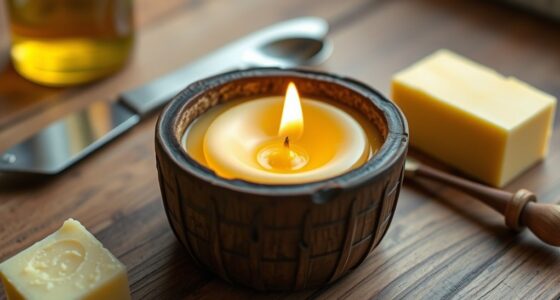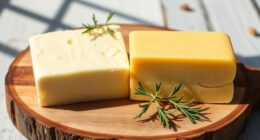Using butter as a pre-coat on your cutting board can really stop stains from setting in. It creates a protective barrier, filling the wood pores to prevent juices and oils from seeping in. Plus, it adds a nice sheen, keeping the board looking fresh. The application is simple: just melt some unsalted butter, spread it evenly, let it soak, and wipe off the excess. Stick around to learn more about enhancing your board’s longevity and maintenance!
Key Takeaways
- Butter creates a protective barrier on the cutting board, preventing stains from penetrating the wood pores.
- Applying melted unsalted butter fills small wood pores, reducing stain absorption and minimizing scrubbing efforts.
- Regularly using butter helps maintain the board’s vibrant appearance and extends its overall lifespan.
- The application process is simple: melt butter, spread evenly, let soak, and wipe off excess after 10 minutes.
- Incorporating butter into your maintenance routine proactively reduces stain formation, supporting ongoing kitchen tool care.

When you think about maintaining your cutting board, you might not realize that a simple layer of butter can make a notable difference. Many people overlook the power of this kitchen staple in protecting their cutting boards. By applying a thin coat of butter, you create a barrier that helps prevent stains from penetrating the wood. This kitchen hack is not only easy but can also extend the life of your board, making it a must-try for anyone who spends time in the kitchen.
A simple layer of butter can protect your cutting board and extend its life, making kitchen maintenance effortless.
First, let’s talk about the stain removal aspect. When you cut fruits, vegetables, or meats on your board, juices and oils can seep in, leading to unsightly stains. A pre-coat of butter helps reduce this absorption. It fills in the small pores of the wood, making it harder for those stains to set in. If you’ve ever struggled to remove stubborn stains, you know how frustrating it can be. By using butter as a preventive measure, you can save yourself from those tedious scrubbing sessions later.
Applying butter is a straightforward process. Start with a clean, dry board. Melt a small amount of unsalted butter until it’s just liquid, then use a cloth or paper towel to spread it evenly over the surface. Allow it to soak in for about 10 minutes, then wipe off any excess. This quick routine not only protects your board but also adds a touch of flavor to anything you prepare on it. It’s a win-win situation!
Additionally, butter can help maintain the natural sheen of your cutting board. Over time, boards can become dull and lifeless. By incorporating this simple kitchen hack into your maintenance routine, you can keep your board looking vibrant and new. Plus, it’s a great way to use up leftover butter instead of letting it sit in the fridge.
Of course, you can’t rely solely on butter for stain removal. If you do encounter stains despite your preventive efforts, consider using a mixture of baking soda and water as a gentle scrub. This combination can lift stubborn marks without damaging the wood. However, by using butter as a pre-coat, you’ll considerably reduce the chances of stains forming in the first place.
Incorporating butter into your cutting board care routine is an easy, effective way to maintain its beauty and functionality. You’ll find that this little kitchen hack makes a big impact on how your cutting board looks and performs over time. Additionally, using online resources can help you find effective ways to care for your kitchen tools.
Frequently Asked Questions
Can I Use Any Type of Butter for This Method?
You can use any type of butter for this method, but keep in mind the butter consistency. Softened butter spreads easily and penetrates better, while harder butter may not coat as well. If you’re looking for alternatives, consider using oils like mineral or coconut oil, which also protect your cutting board. Just remember, the key is to create a barrier that prevents staining, so choose whatever works best for you!
How Often Should I Apply the Butter Pre-Coat?
You should apply the butter pre-coat every few weeks, depending on usage. Regular maintenance helps enhance butter longevity and protects your cutting board from stains. If you notice the surface looking dry, it’s time to reapply. You might also consider alternative coatings like mineral oil or beeswax for long-term protection. These options can keep your board in great shape, but butter adds a unique flavor and charm to your kitchen tools.
Does Butter Affect Food Taste When Cutting?
Butter doesn’t just coat your cutting board; it adds a subtle layer of flavor that dances on your palate. When you slice through ingredients, you might catch a hint of butter seasoning, but it’s usually minimal. Most foods retain their natural taste, so the flavor impact’s negligible. Just keep in mind that if you’re cutting strong-flavored items, the butter’s influence might not be as noticeable. Enjoy your culinary adventures without worry!
Is This Method Safe for All Wood Types?
Yes, this method is generally safe for most wood types, but you should consider oil compatibility. Different woods absorb treatments differently, so it’s crucial to know your cutting board’s material. For example, softer woods might absorb butter better, while harder woods could resist it. Always test a small area first to guarantee there’s no adverse reaction. Regular oiling with compatible oils can also help maintain your board’s integrity and prevent staining.
What Should I Do if My Board Still Stains?
If your board still stains, don’t panic! Think of it as a stubborn superhero that just won’t give up. For effective stain removal, mix baking soda with water to make a paste and gently scrub the stained area. Rinse thoroughly and dry it immediately. For ongoing board maintenance, regularly oil your cutting board with food-safe mineral oil to create a protective barrier, keeping those pesky stains at bay.
Conclusion
In conclusion, using butter as a pre-coat on your cutting board can be a game changer in preventing stains. Not only does it create a protective barrier, but it also adds a touch of flavor to your food. Did you know that wooden cutting boards can absorb up to 30% more moisture than plastic ones? So, taking care of your wooden board with butter not only keeps it looking good but also helps maintain its integrity for years to come.









